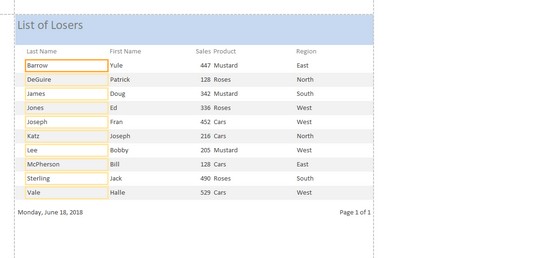By using an Access report, you get a different view of your data. By manipulating the data in an Access report, you create alternate views of the same report. Some common ways to extract information from an Access report include counting, sorting, and filtering.
Switching an Access report to Layout view
To manipulate data in an Access report, you must first display your report in Layout view, which you can do by following these steps:- In the All Access Objects pane (the left pane of the Access window), double-click the report name.Access displays your chosen report.
- Click the Home tab. In the Views group, click the downward-pointing arrow below the View icon.A pull-down menu appears.
- Choose Layout View.Access displays your report in Layout view, which highlights an entire column (field) at a time.
 Layout view highlights a single column of your report so you can manipulate the data in the highlighted field.
Layout view highlights a single column of your report so you can manipulate the data in the highlighted field.
Counting records or values in Access 2019
To make reports more useful, you can have Access count and display information. For example, you might want to know which products are selling the best or the total dollar amount of each sale so you can tell exactly how much money your company made during March. By counting records or adding up values stored in fields, Access can help you better interpret the data displayed in a report.To count the number of records or values in an Access report, follow these steps:
- Switch to the Layout view of your report by following the steps above.
- Right-click in the column (not the column heading) that you want to count.
Access highlights your chosen column and displays a pop-up menu.
 Right-click a column to display a pop-up menu for manipulating your data.
Right-click a column to display a pop-up menu for manipulating your data. - Click Total.
The menu command displays the Total command along with the field name you right-clicked, such as Total Last Name or Total Sales. Access displays a submenu that displays Count Records or Count Values.
- Choose either Count Records or Count Values.
Access displays the total count in your report.
If you choose the Count Records or Count Values command again, you can hide the total count in your report.
Sorting a field in Access 2019
Access can sort each field in ascending or descending order. Sorting a field simply rearranges the data in your report for your convenience. To sort a column (field) in an Access report, follow these steps:- Switch to the Layout view of your report by following the steps above.
- Right-click in the column (not the column heading) that you want to sort.
Access highlights your chosen column and displays a pop-up menu.
- Choose one of the following:
- Sort A to Z (or Sort Smallest to Largest): Sorts in ascending order
- Sort Z to A (or Sort Largest to Smallest): Sorts in descending order
Access sorts your chosen data in your report.
Filtering a field in Access 2019
Filtering tells Access to display only data that meets a certain criterion, such as a fixed amount. For example, if you have a report that lists all the sales of products, you can filter your report to show only those products that sold over $1,000.To filter data in a field, follow these steps:
- Switch to the Layout view of your Access report by following Steps 1 through 3 above.
- Right-click in the column (not the column heading) that you want to filter.Access highlights your chosen column and displays a pop-up menu.
- Choose a filter, such as Text Filters or Number Filters.Depending on the type of data your column contains, the Filter command may appear as Text Filters or Number Filters. A submenu appears.
 The Filters command displays a submenu of different criteria you can choose from.
The Filters command displays a submenu of different criteria you can choose from. - Choose a filter criteria, such as Sum or Average.Depending on the criteria you choose, a Custom Filter dialog box appears.
- In the Custom Filter dialog box, type your criteria, and then click OK.Access applies your filter to your report.
You can always turn off your filter by clicking the Home tab and then clicking the Toggle Filter icon in the Sort & Filter group.






